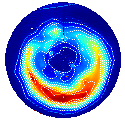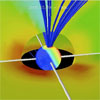AIM Models
Assimilative Mapping of Ionospheric Electrodynamics (AMIE):
 The AMIE procedure is an optimally constrained, weighted least-squares fit of electric potential distribution to diverse types of atmospheric observations. Knowledge of these distributions is important in many areas of magnetospheric, ionospheric, and thermospheric physics.
The AMIE procedure is an optimally constrained, weighted least-squares fit of electric potential distribution to diverse types of atmospheric observations. Knowledge of these distributions is important in many areas of magnetospheric, ionospheric, and thermospheric physics.
Coupled Magnetosphere Ionosphere Thermosphere Model (CMIT):
 There are several boundary layers to take into consideration in space physics near the Earth. The solar wind generates a shock at the outter boundary of the magnetosphere. The inner magnetosphere affects auroral activity at the ionosphere boundary, which drives certain processes at the thermosphere. In order to better understand these interactions, we have created the Coupled Magnetosphere Ionosphere Thermosphere (CMIT) model.
There are several boundary layers to take into consideration in space physics near the Earth. The solar wind generates a shock at the outter boundary of the magnetosphere. The inner magnetosphere affects auroral activity at the ionosphere boundary, which drives certain processes at the thermosphere. In order to better understand these interactions, we have created the Coupled Magnetosphere Ionosphere Thermosphere (CMIT) model.
Global Scale Wave Model (GSWM):
 The GSWM solves the linearized and extended Navier-Stokes equations for steady-state global temperature and wind perturbations. GSWM may be used to calculate an "unforced" planetary wave response for a specified period and zonal wavenumber, or the thermally-driven response for either a diurnal or semidiurnal atmospheric tide.
The GSWM solves the linearized and extended Navier-Stokes equations for steady-state global temperature and wind perturbations. GSWM may be used to calculate an "unforced" planetary wave response for a specified period and zonal wavenumber, or the thermally-driven response for either a diurnal or semidiurnal atmospheric tide.
Thermosphere Ionosphere Electrodynamic General Circulation Models (TGCMs):
 The NCAR TGCM's are three-dimensional, time-dependent models of the EARTH's neutral upper atmosphere. The model uses a finite differencing technique to obtain a self-consistent solution for the coupled, nonlinear equations of hydrodynamics, thermodynamics, continuity of the neutral gas and for the coupling between the dynamics and the composition.
The NCAR TGCM's are three-dimensional, time-dependent models of the EARTH's neutral upper atmosphere. The model uses a finite differencing technique to obtain a self-consistent solution for the coupled, nonlinear equations of hydrodynamics, thermodynamics, continuity of the neutral gas and for the coupling between the dynamics and the composition.
Whole Atmosphere Community Climate Model (WACCM):
 WACCM is a comprehensive numerical model, spanning the range of altitude from the Earth's surface to the thermosphere. The development of WACCM is an inter-divisional collaboration that unifies certain aspects of the upper atmospheric modeling of HAO, the middle atmosphere modeling of ACD, and the tropospheric modeling of NCAR Community Climate System Model CGD, using the (CCSM) as a common numerical framework.
WACCM is a comprehensive numerical model, spanning the range of altitude from the Earth's surface to the thermosphere. The development of WACCM is an inter-divisional collaboration that unifies certain aspects of the upper atmospheric modeling of HAO, the middle atmosphere modeling of ACD, and the tropospheric modeling of NCAR Community Climate System Model CGD, using the (CCSM) as a common numerical framework.
 The AMIE procedure is an optimally constrained, weighted least-squares fit of electric potential distribution to diverse types of atmospheric observations. Knowledge of these distributions is important in many areas of magnetospheric, ionospheric, and thermospheric physics.
The AMIE procedure is an optimally constrained, weighted least-squares fit of electric potential distribution to diverse types of atmospheric observations. Knowledge of these distributions is important in many areas of magnetospheric, ionospheric, and thermospheric physics.
 There are several boundary layers to take into consideration in space physics near the Earth. The solar wind generates a shock at the outter boundary of the magnetosphere. The inner magnetosphere affects auroral activity at the ionosphere boundary, which drives certain processes at the thermosphere. In order to better understand these interactions, we have created the Coupled Magnetosphere Ionosphere Thermosphere (CMIT) model.
There are several boundary layers to take into consideration in space physics near the Earth. The solar wind generates a shock at the outter boundary of the magnetosphere. The inner magnetosphere affects auroral activity at the ionosphere boundary, which drives certain processes at the thermosphere. In order to better understand these interactions, we have created the Coupled Magnetosphere Ionosphere Thermosphere (CMIT) model.
 The GSWM solves the linearized and extended Navier-Stokes equations for steady-state global temperature and wind perturbations. GSWM may be used to calculate an "unforced" planetary wave response for a specified period and zonal wavenumber, or the thermally-driven response for either a diurnal or semidiurnal atmospheric tide.
The GSWM solves the linearized and extended Navier-Stokes equations for steady-state global temperature and wind perturbations. GSWM may be used to calculate an "unforced" planetary wave response for a specified period and zonal wavenumber, or the thermally-driven response for either a diurnal or semidiurnal atmospheric tide.
 The NCAR TGCM's are three-dimensional, time-dependent models of the EARTH's neutral upper atmosphere. The model uses a finite differencing technique to obtain a self-consistent solution for the coupled, nonlinear equations of hydrodynamics, thermodynamics, continuity of the neutral gas and for the coupling between the dynamics and the composition.
The NCAR TGCM's are three-dimensional, time-dependent models of the EARTH's neutral upper atmosphere. The model uses a finite differencing technique to obtain a self-consistent solution for the coupled, nonlinear equations of hydrodynamics, thermodynamics, continuity of the neutral gas and for the coupling between the dynamics and the composition.
 WACCM is a comprehensive numerical model, spanning the range of altitude from the Earth's surface to the thermosphere. The development of WACCM is an inter-divisional collaboration that unifies certain aspects of the upper atmospheric modeling of HAO, the middle atmosphere modeling of ACD, and the tropospheric modeling of NCAR Community Climate System Model CGD, using the (CCSM) as a common numerical framework.
WACCM is a comprehensive numerical model, spanning the range of altitude from the Earth's surface to the thermosphere. The development of WACCM is an inter-divisional collaboration that unifies certain aspects of the upper atmospheric modeling of HAO, the middle atmosphere modeling of ACD, and the tropospheric modeling of NCAR Community Climate System Model CGD, using the (CCSM) as a common numerical framework.
